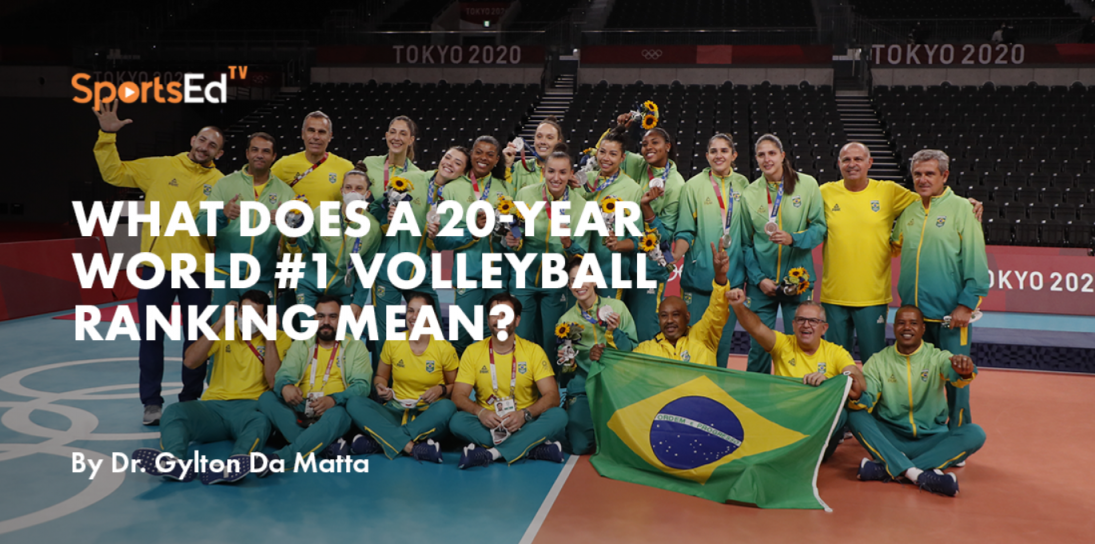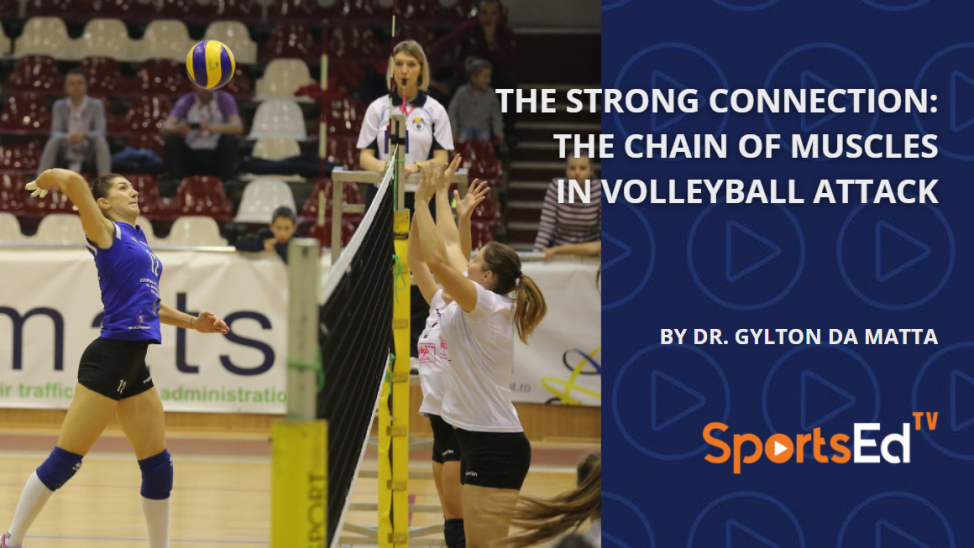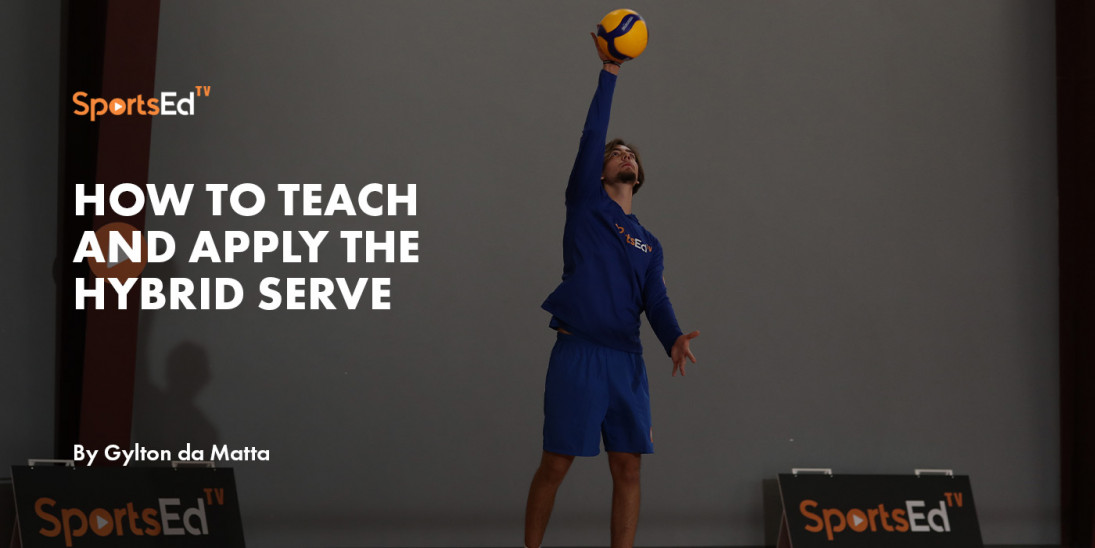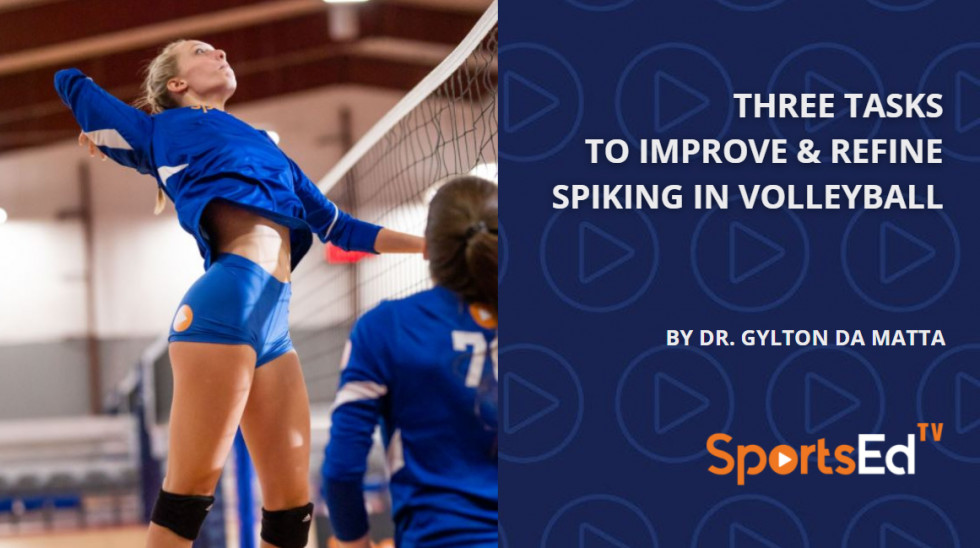Volleyball
Welcome and thanks for visiting...

How To Dive In Volleyball?
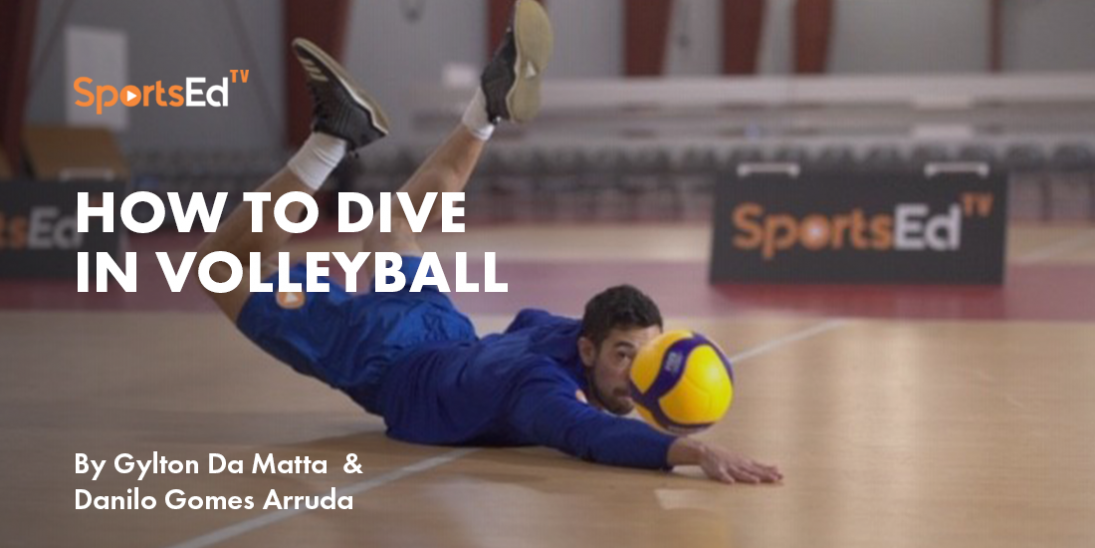
As volleyball evolves as a fast-paced sport, players frequently have to execute acrobatic movements on defense, such as dives, rolls, and amazing leaps over chairs, signs, and bleachers to recover a ball. Many acrobatic moves create spectacular plays in mega rallies.
Although many coaches say that a volleyball player does not need to go to the ground, the deflections from the block or unexpected drop shots performed by hitters require all players the ability to dive and recover volleyballs that are far away from them. This normally happens on serve-receive or on defense. What most people do not know if that being able to master diving is more than a basic fundamental skill, it is a signature of passion and pride!
How to dive in volleyball?
Diving is a complex skill that requires proper practice and needs to be trained using coaching expertise so players can learn how to perform a dive safely and keep the ball in play. Diving requires upper body strength, trunk to limbs coordination, and a lot of timing and accuracy! Due to its complexity, we would like to suggest an efficient progression that should be taught and implemented by an experienced coach or volleyball teacher.
In this article, we will utilize the whole-part-whole approach and an analytical method to break down this advanced and complex defensive acrobatic skill. In many countries, diving is considered a basic skill and in others, it is considered an advanced “extraordinary” movement. In the Deliberate Practice method, volleyball players should make the “extraordinary” ordinary and be able to use both the essential “ordinary” skills as well as exceptional abilities in their movement repertoire. Every volleyball player should be proud of being able to dive properly and efficiently in order to execute digs through diving, risk-free and injury-free.
This reflection will show how to teach "penguin diving" in combination with the "pancake." Those skills are mostly used by men's volleyball, but many female advanced players execute the dive by sliding on their stomachs without any problem.
Topology of Volleyball Dive

Just like in life, keeping one’s chin up is the critical element of a successful and safe dive. In the dive, keeping the player’s chin up leads to the execution of the entire skill and allows them to keep looking at the ball at all times.
Step-by-step analysis of Volleyball Dive
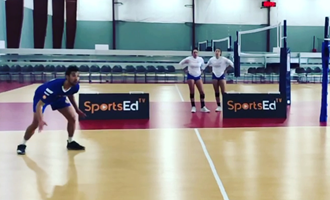
A. Preparation phase: Player is in the ready position and reads possible shots.
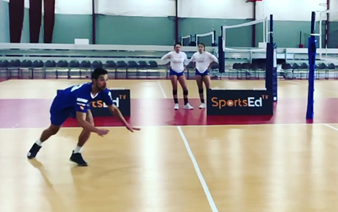
B. Execution phase: The player commits to perform the dive knowing that this is the best technical option.
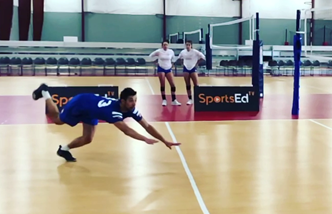
C. Chin up! With eyes on the ball, the player extends contact and landing arms preparing for take-off from one foot.
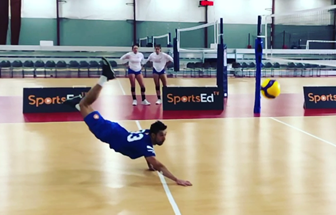
D. Flight phase: with the chin up, the player lands with both hands (contact hand arm extended and support arm bent). The support hand is fully open with the elbow supporting the body. Contact hand slides with the elbow extended. The player must aim the back of the hand to place it exactly at the projection to where the ball will land.
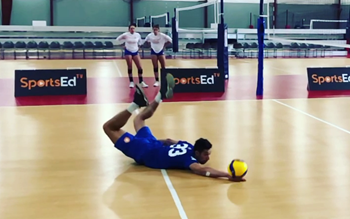
E. Contact phase: Chin up…watching the ball, place the back of the hand under the ball, and let it bounce off. Holding hand pushes off propelling the body forward. Chest/ stomach slides forward, followed by hips then the lower body. Legs are relaxed up, but both feet need to be pointing the toes in preparation to finish the act.
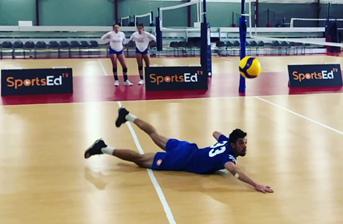
F. Follow-through and transition phases: The player keeps watching the ball and with a push-up, transitions into a new action in the game (e.g., go back to base or prepare for another technical performance).
How to teach the volleyball dive? (Teaching expertise note!)
When teaching the volleyball dive, coaches must follow a progression without skipping any task of the proposed developmental analysis so that athletes develop the strength, agility and proper technique needed to safely execute this movement. During a period of two weeks of practice, coaches and players must agree to be patient and master each task prior to moving on to the next tasks or phases of this task presentation.
Players need to learn how to keep the chin up, learn the undulation of the body, and acquire the necessary upper body strength prior to attempting to learn this complex and advanced skill.
While many expert coaches have been teaching this skill for years, recently, many recreational coaches have risen to Head Coaching positions and brought with them a new mentality to leave out this skill. Each coach and player must decide if they know how to attempt to learn this skill or not! The consequence is hesitancy and conflict among players about whether to dive. However, we have observed that when coaches do not teach this skill properly, players go to the ground without any preparation and they get bruises or contusions because they do not know how to properly go to the ground. The same is true with learning other ground movements such as the shoulder roll and the log roll (also called the hip roll).
Next, we will suggest teaching tasks that can be customized and modified to suit each volleyball player by his/her volleyball coach.
The progressions contain five stages with distinct types of exercises:
- Acquiring upper body strength using a push-up
- Developing axial-limbs coordination with a swiss ball
- Practicing the movement without a ball on a gymnastics mat
- Performing the dive (with and without props) on the volleyball court
- Applying the movement with a volleyball, with a symmetrical and asymmetrical pattern.
The developmentally appropriate movement analyses and technical-tactical application will be helpful here. The idea is to progress with tasks from simplest to more complex and from easy to more difficult regarding the task organization. Thus, this task presentation progresses from very slow up to real-time speed.
The next steps will represent a chronological sequence for teaching those movements and add volleyball after the player demonstrates full control of the body going to the ground with a smooth slide. This needs to be done properly and supervised by a professional instructor, volleyball expert, or certified physical educator/ volleyball master.
Showing and explaining the skill
Informing task: In this phase, the coach should explain the goal of the dive and show/demonstrate how the skill looks in a game situation. When a pass or defense action in a regular defensive posture is not possible, (e.g., the ball is too far away or comes too low/high) dive should be used as a last resort to keep the ball alive. Playing the ball is critical and the dive functions as a follow-through. It can also be used when the player contacts the ball without balance, and the dive serves as an injury-prevention strategy. For instance, instead of landing unbalanced and on one foot, the player dives to absorb the impact.
In order to do a safe dive, three basic things should be done. (1) getting closer to the floor (usually doing a lunge), (2) contacting the ball up, (3) absorbing the impact, and (4) moving the chin up.
Volleyball Wall familiarization exercise (developing upper body strength)
Pre-requisite task: Power, strength, and coordination
With the body leaned 45 degrees, about two feet away from the wall, athletes do push-ups touching the chest on the ground and sliding the body forward.
While flexing the elbows, the athlete should bring the chin upwards.
The back should be arched, similar to the real movement.
The arms start extended, and during the lowering phase of the movement, the elbows flex, and smoothly the chest touches the ground.
The movement resembles a wave, and therefore, the trunk should not be straight.
Application
Doing this whole exercise sequence about 10 times.
Highlight the importance of the chin being up and the wave movement pattern.
After executing this movement on the mat, the player should do the same on the floor, adding an elbow extension to push the body forward.
This exercise can be executed with symmetrical hands, or (in the case of the pancake) the dominant arm can be extended with the palms on the floor and flexing just the other elbow as a simulation of the real dive.
Swiss ball familiarization exercise
(all refinements should start from this initial position)
Extension tasks with refinements toward diving
This time a swiss ball will be placed on the gymnastic mat, and the athlete should lay his legs on a swiss ball doing the diving movement, pulling the body down from a stationary position. While flexing the elbows, the athlete should allow the body to roll over the ball and go forward using the wave movement pattern, and finish it off the ball. It is recommended about 10 repetitions with each hand position (symmetric and pancake).
Variation 1: Start the movement by holding a volleyball. The athlete should initiate the movement with the ball and as the chest is getting closer to the floor, he should throw the ball to the coach and place the hands in the appropriate place (symmetric and pancake). Ten repetitions should be allocated for this variation.
Variation 2: This time, the coach will toss the ball and the athlete should first hit the ball up (one or two hands) and finish the movement by doing the dive from the swiss ball. Also, ten repetitions are recommended.
Variation 3: The same sequence can be executed, but the athlete starts in a standing-up position. The movement begins by doing a lunge and getting lower (i.e., closer to the ball/floor), and the athlete should slide his chest/ her stomach onto the ball and finalize a smooth slide on the ground.
Variation 4: Starting from the very, very, very low position…use one long forward lunge step and displace a ball from the ground (upwards) and then execute a dive on the ground (slow, slow, then a little faster). Alternate the take-off foot.
Variation 5: Starting from the very, very, very low position, the performer tosses a volleyball in front of his/her body and executes the dive on a mat. If the toss is very high, he/she can execute the pancake (placing the hand underneath the ball before it bounces on the ground.
SAFETY: Always keep the chin up and maintain eyes on the ball. CHIN UP UP UP!
Using a gymnastic mat
Using a mat only, the athlete should do a forward lunge to get lower and further from the starting position, and then pull his chest to the floor, the legs naturally go up, similarly to a whipping or wave movement. The coach might add a string to serve as an external reference for the athlete to jump over and not hit the hips first on the floor. Some forward speed is required, otherwise, the athlete will not be able to slide on the floor. Therefore, the lunge should be executed fast. The same sequence as the progression with the swiss ball can be executed using ten repetitions each.
Without any equipment
(after two or three weeks of continuous and daily practice with the first 4 progressions)
By now, the athlete should have a basic understanding of executing a dive and be better prepared to try out the movement using the court. The same progressions should be performed, but this time without any extra equipment. Learning how to dive takes time and expert coaches should understand that learning without fear of trauma in a fun environment is 1000 times better than learning under undue pressure.
EXTRA: Small-Sided Games
Application tasks towards developing automaticity of the diving movement.
In order to apply the technique in a game-like situation, the athletes have to practice the skill in a similar context. Thus, a 2v2 game might be utilized. One player should be the setter and the other one the defender. Only tips are allowed, and the defender, before the opponents' attack, should be behind the cones (~20 feet away from the net ) (Figure3?). The attack should fall in the attack zone (ten-foot line). The game runs like a regular volleyball game, and the coach might add or change rules to optimize dive learning.
Common mistakes
Please avoid these mistakes and do not go forward until there is no occurrence of these movement errors
-Lack of undulation movement (chest and belly touching the floor at the same time) – the chest should touch the floor first, and then the belly, and then the hip and thighs. Normally because of a lack of upper body strength.
-Head down (a misconception that body wave happens from the head…it does not!) The body wave originates from the chest/ stomach and finishes on the hips, legs, pointing toes, and final hand push.
-Diving from a high position instead of a low one (all defense happens in a very low body position, even when in motion to pursue the ball).
-Diving too slow and consequently not sliding. (If the player is slow, he/she is not ready to play the ball yet; slowing down is a mechanism of defense, perhaps because the player is afraid or simply is not ready yet. Thus more practice on the mat and the execution of pre-requisite tasks are needed without the ball).
-For pancake, not keeping the dominant arm extended while it slides on the floor to reach the ball.
- Also in the case of pancakes, not pointing the toes hinders the extension of the whole body (doing some handstands focusing on pointing both toes can be very helpful for body awareness and application in dive coordination).
Final Conclusion
Diving, as any fundamental of the game, is fun, but it is not easy. If athletes acquire this movement, the whole team's defensive system can gain from it. The coach must have the patience to teach and be aware of the refinements needed to correct the basic mistakes. Be proactive to fix them ahead of time (feedforward) to decrease the odds of injury while also improving efficiency.
One of the authors learned to dive by practicing at home on his bed. Instead of lying down like a regular person, he would dive into the bed to practice the wave movement. So far, he has never broken any beds by doing that, and he has always received positive feedback when he has given that suggestion to his athletes and. Feel free to try it yourself!
Learning how to dive properly takes about two to three weeks to master each stage of this progression.
Keep your chin up and play defense like an expert!
Authors:
Danilo Gomes Arruda is a Ph.D. Graduate Student at the University of Minnesota in the Motor Learning/ Motor Control Program.
Dr. Gylton Da Matta is a Ph.D. in Sports Pedagogy/ Motor Learning/ Motor Control and he is an instructor and researcher in these areas. Dr. Da Matta is also the Volleyball Executive Director for SportsEdTV Dr. Da Matta is the author of the Deliberate Practice Volleyball Method, author/ editor of 21st Century Volleyball Expertise book, and Technical Evaluator of the FIVB. Dr. Da Matta consults for the top-ranked volleyball teams in Brazil and researches expertise development for volleyball coaches and volleyball players.



